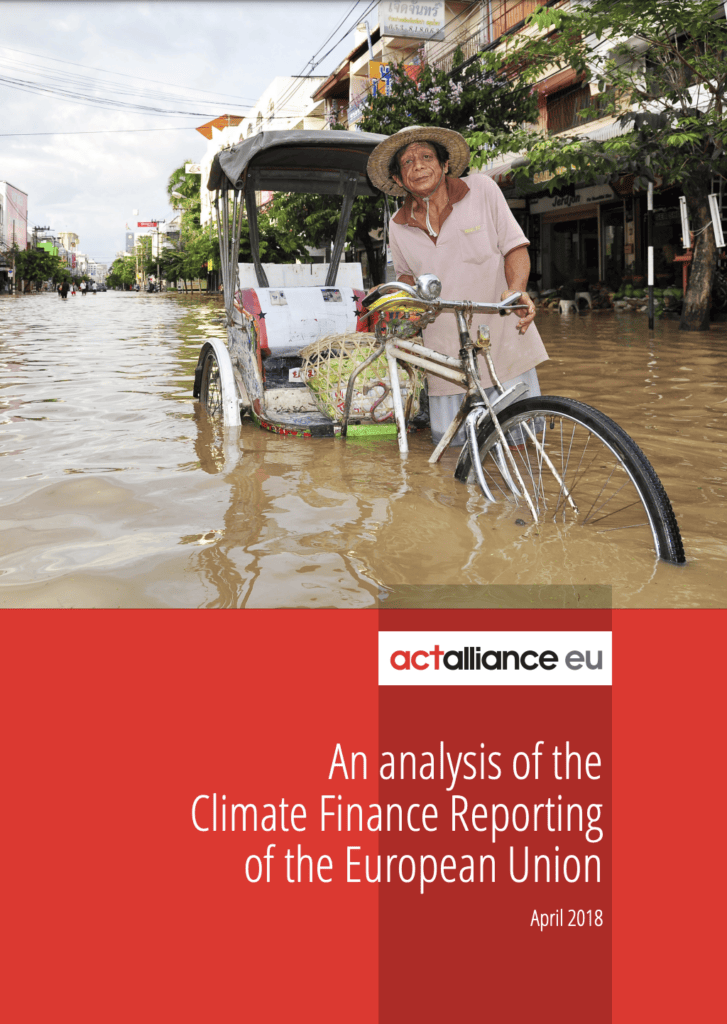The EU and its Member States constitute the largest donor for development, humanitarian, and climate finance to developing countries. However, focusing solely on monetary amounts could be misleading. To accurately assess the impact of development on impoverished and vulnerable nations, it’s essential to examine how funds are reported and allocated. In response, ACT Alliance EU commissioned an analysis of climate finance reporting by EU institutions and Member States on an annual basis. This research yielded several noteworthy findings, detailed in this report.
Climate finance – a game of numbers?
This report highlights several challenges that need addressing. If developed countries genuinely commit to assisting poorer and more vulnerable nations with climate finance, it should not devolve into a mere numbers game that distorts reality. Instead, it ought to involve the flow of funds aimed at generating climate action.
Discussions on accounting, intertwined with parallel talks concerning the transparency of climate finance, are pivotal for the success of the summit in Poland this December. Without clarity on financial flows, developing countries may hesitate to progress discussions on other topics. Western countries might portray this as obstructionism. However, with minimal new funds available, actions will be limited, and without agreed-upon action, mitigation and adaptation targets will remain unmet.
So, what are the issues? The EU climate finance report identifies four areas requiring improvement and consensus.
- Absence of Funds for Adaptation
As repeatedly documented, climate finance from developed countries tends to favour mitigation. The report shows positive signs of the EU attempting to strike a balance between funding for mitigation and adaptation. For instance, the European Development Fund, the European Commission, and a few EU member states, such as Ireland and Belgium, exhibit a strong commitment by allocating over half of their support to adaptation. However, despite these instances, the overall picture remains clear: only 30% of total climate finance is allocated to adaptation.
Developed countries are increasingly focusing on loans and private finance. However, past experiences reveal that these funds predominantly favour mitigation, making achieving balance even more challenging. Notably, the European Investment Bank, a major provider of loans, allocated only 4% of its support to adaptation in 2016.
- Climate Aid Delivered as Loans
Loans constitute over 40% of climate finance provided by EU institutions, and for some EU member states like France and Spain, loans form the majority of their support. While loans can play a crucial role, especially in “bankable” projects yielding returns, they contradict the fundamental principle of “polluter pays” since they must be repaid.
Some loans include a grant element; if this exceeds 25% of the total loan, it’s termed concessional. OECD regulations state that only concessional loans can be considered development aid. However, no such restriction exists for climate finance, despite the general argument from developed countries that climate finance and regular development aid should align. Consequently, only concessional loans should qualify as climate finance, following the same practice as for development aid.
Furthermore, adhering to the “polluter pays” principle and ethical considerations, only the grant equivalent of a loan should be counted. For countries like France, where loans make up nearly all of its support, this adjustment would halve the amount counted as climate finance.
- Neglect of Poor and Vulnerable Countries
The report highlights how a significant portion of climate finance is directed towards wealthier developing countries. From 2013 to 2016, the EU’s total support to Turkey equalled that given to all Least Developed Countries combined. Private investments, receiving increased attention, are more likely to yield returns in emerging economies. With a greater emphasis on loans and private finance, support to these countries is likely to rise.
This trend requires acknowledgment and discussion. While many countries require support, the poorest and most vulnerable nations urgently need action. With limited ability to attract private investments, they rely on support from developed countries. In middle-income countries like Turkey, where attracting private investments and loans is easier, these should not necessarily be reported as climate finance.
- Double Counting of Funds
An ongoing debate concerning climate finance revolves around the term “new and additional.” Initially included in the climate change convention to address developing countries’ concerns that climate change challenges would divert funds from existing development needs, the EU acknowledges the term but interprets it differently, contradicting recommendations agreed upon by the UNFCCC Standing Committee on Finance. Furthermore, substantial portions of EU climate finance are reported to the UN both as development aid and climate finance.
Lack of transparency and double counting erode trust and impede progress in negotiations. When parties convene to agree on accounting and transparency of climate finance, it’s crucial that they establish rules ensuring that agreed-upon support yields tangible results. Debates about climate finance should transcend mere numerical games; the primary objective should focus on mobilising the necessary support to enable developing countries to undertake crucial adaptation and mitigation actions.
